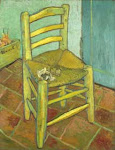The fall semester is winding down. That means a whole lot of grading, plotting syllabi for next semester, planning projects for Christmas break, and in my case, thinking ahead to summer travels. About this time every year, the road starts to call, and the wanderlust kicks in. I look at maps and think, where do I want to go this summer? What destination is whispering to me? My last three trips abroad have all featured Paris, and one of them (in 2007) included the Netherlands and Provence...my van Gogh research trip for "Sunflowers." But where to next? Ma sì, ho già deciso...andiamo!
I believe in meaningful travel. I don't choose my voyages on a whim; often there's a project linked to a trip, but not always, sometimes it's about where I am in my life and thinking, and where my footsteps are leading me. For me, travel is a pilgrimage. I become a seeker of ideas as well as things, I open myself to new experiences and people, I plan my way but also allow for the wind to blow as it will. And I've been rewarded: sure, not every destination has yielded sublime moments, but many have. Some have brought outright inspiration -- as I keep saying, I never would have written "Sunflowers" if I hadn't gone to Auvers-sur-Oise that May day in 2006. It's just a fact. That place and that day spoke to me.
How to make travel meaningful? Once I choose my destination, the planning begins. I don't mean a rigid itinerary on a clipboard that tracks every minute of the journey; I mean mental preparation. This can include brushing up on language skills -- I'm already wandering the apartment reciting Italian verb conjugations -- reading up on the art and history of where I'm going, listening to music related to the place, reading novels set in the place. And studying maps. I *love* maps. The Streetwise series of maps is my favorite; they're easy to use and discreet, so you can peek at them without holding a big I'M A LOST FOREIGNER sign. I like to feel familiar enough with the city in question so that on arrival day, I'm ready to jump right into things without wasting a second. Other advance planning includes creating a small notebook with lists of opening hours for places I want to see, timetables for trains and buses if I need them, as much practical information as I can get in advance (nowadays, so easy with the internet). I choose my accommodations as far out as I can; I might note some good restaurant recommendations, but with restaurants I prefer to choose what looks good when I'm actually there.
During the trip, I see what I'm in the mood for on a particular day. I may wake up in a museum mood, or on a beautiful morning, I may want a day that has a lot of walking outside. Do I journal? Um...no. I try. Every trip, I try. With the best of intentions, I leave plenty of blank pages in my trip notebook, but it seldom happens. I find myself mute at the very moments I'd like to have words of wit and wisdom to record. Nothing I say seems to really capture what I'm feeling and seeing. It's ironic, I know that, but I guess I'm just not a journaling kind of person.
I do keep relics of my pilgrimages. Ticket stubs, restaurant receipts, funny this-and-that often dumb things that nonetheless have the power to conjure up a time and place. Just the other day, I reached into the pocket of a jacket I hadn't worn since May to find a used Paris Metro ticket. It made me smile. To give another example, in one of my 'reliquaries' -- boxes wherein reside the relics of many journeys -- lies a pair of sunglasses held together by a safety pin. I dropped and broke those sunglasses in the Piazza della Signoria in Florence in October 1996, while trying to shift a cone of the best gelato I've ever tasted from hand to hand. I only have to pick up the glasses to remember the magic of seeing the Piazza for the first time. From the van Gogh trip in 2007, of course, I've got any number of postcards, brochures, and photographs. I've even got sugar cubes in a Musée d'Orsay wrapper -- I remember when I stashed them and how I felt that afternoon, giddy with too much caffeine and too many fabulous paintings.
Ah yes, the road is calling. Will I drop my sunglasses in the Piazza della Signoria this summer too? What relics and ideas and inspirations will I bring home this time?
For good reading on meaningful travel, I recommend Phil Cousineau's "The Art of Pilgrimage: The Seeker's Guide to Making Travel Sacred" and Joseph Dispenza, "The Way of the Traveler: Making Every Trip a Journey of Self-Discovery," both available on Amazon.





















